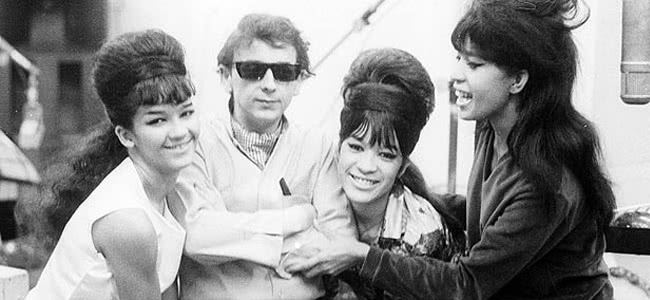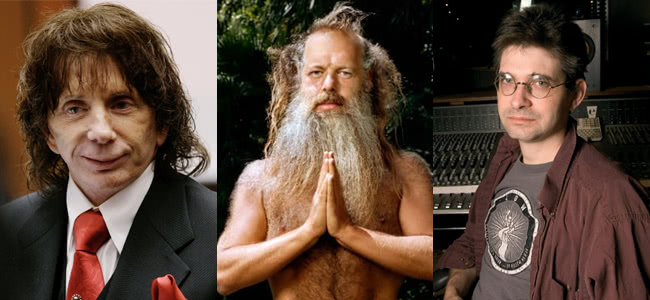Being able to play an instrument and write a song is one thing, but the importance of presenting and framing that music and getting ‘that’ elusive sound is something else entirely. Enter the world of the music producer.
Whether their role is technical, engineering expensive gear and working all those intimidating buttons and knobs on the sound desk, to offering a sense of stylistic direction, or just plain getting the band mates to stop bickering enough to get into the sound booth; the producer’s part in the making of a record simply cannot be understated.
They’ve shaped entire musical movements (such as Berry Gordy did with Motown, or Jerry Wexler with Atlantic), sat side by side with history’s best bands (imagine The Beatles without George Martin of Radiohead without Nigel Godrich), cultivated all those great pop songs over the years (from Max Martin and Quincy Jones to Pharrell Williams), to the hallowed halls of hip hop innovation (take a bow Dr Dre and Wu-Tang’s RZA).
There’s as many great producers as their are bands, artists, and genres, but here we’ve whittled it down to six names that have shaped the sound of modern rock as we know it today, thanks to their influential sound techniques and production methods, living the rock star infamy as much as the huge bands and records they’ve worked on.
If you’d ever like to see your own name splayed alongside this hallowed half-dozen, you need to start honing your production work, and what better way to start then by investigating the courses offered at the Australian Institute of Music in Melbourne. It could be your first step into shaping the sound of popular music the way these six figures have.
Rick Rubin

When it comes to a music producer, one typically thinks of some nerdy man or woman hidden away in a studio, a face forgotten. Then there is Rick Rubin, a man who’s legend almost proceeds him.
Once a co-president of Columbia Records, he’s the founder of both Def Jam and American Recordings, as well has having consistently worked over three decades with an unbelievable list of artists, from Beastie Boys to Australia’s own Angus & Julia Stone. Rubin is as big (if not bigger) a personality than those he works with.
Love Music?
Get your daily dose of metal, rock, indie, pop, and everything else in between.
Renowned as one of the best in the biz due to his magician-like ability to turn a record gold, Rubin’s signature sound is usually stripped back, ensuring that clarity and refinement are paramount.
This long bearded production wiz has stuck his finger in just about every genre pie and pulled out the biggest of blockbuster releases from a star-studded list as lengthy as his whiskers. Just think of Red Hot Chili Peppers, Beastie Boys, Slayer, Eminem, Lady Gaga, Mick Jagger, Black Sabbath, Slipknot, his reinvention of Johnny Cash … oh are we rambling?
Here’s just a sample of the incredible records the 51-year-old has produced over 30 years: Beastie Boys – License To Ill (1986), Red Hot Chili Peppers – Blood Sugar Sex Magik (1991), Johnny Cash – American IV: The Man Comes Around (2002), System Of A Down – Toxicity (2011), Adele – 21 (2011), Kanye West – Yeezus (2013).
Phil Spector

When you think of Phil Spector the first things that spring to mind may be: crazy, jail, murder plots… but how about delving a little deeper. Heard of the ‘Wall of Sound’?
As the name aptly suggests, Spector is an originator of the thick, fuzzy sonic layering that refuses any form of silence within a track and in the process innovating one of the most influential production styles ever.
Initially rising to prominence in the 60s with girl groups such as The Ronettes and The Crystals, the now 74-year old was hugely influential on the likes of The Beach Boys and The Beatles, so much so that he was hired to produce many of their records.
Elements from psychedelic rock have borrowed from his original methodology, as well as heavily paving the way for what would be known as art rock and sub-genres such as dream-pop, shoegaze, noise and experimental rock. He may have slid into strange habits (like a waving a gun in the face of the Ramones) but there’s no doubting his rock star credentials.
Spector’s CV is very healthy indeed, having produced records such as: A Christmas Gift For You From Phillies Records (1963), The Ronettes – Presenting the Fabulous Ronettes Featuring Veronica (1964), Ike & Tina Turner – River Deep – Mountain High (1966), The Beatles – Let It Be (1970), George Harrison – All Things Must Pass (1970), The Ramones – End Of The Century (1980).
Steve Albini

Who knows where or what alternative rock would be today without this Californian native. Infamous for his pioneering work into the world of grunge, with his overall heavy hitting distorted aesthetic. The name Albini has become synonymous with a loud brazen sound.
The first band that obviously springs to mind is the Pixies, to which the prolific producer was responsible for the final cut of their 1988 release Surfer Rosa, which – as history goes – caught the attention of one Kurt Cobain, whom demanded above all else that Albini be enlisted to helm Nirvana’s third (and final) record, In Utero.
Growing up with such bold influences in noise and gross distortion from the likes of The Stooges, The Velvet Underground, The Ramones, The Birthday Party, Public Image Ltd and the ilk it’s no wonder that this man’s studio work results in such raw and naturally organic records. His sound as recognisable as any of the big-name acts he worked for.
Steve Albini’s production contributions include: Big Black – Atomizer (1986), Pixies – Surfer Rosa (1988), The Breeders – Pod (1990), The Jesus Lizard – Goat (1991), Nirvana – In Utero (1993), Dirty Three – Ocean Songs (1998), Mogwai – My Father, My King (2001), Joanna Newsome – Ys, (2006), Cloud Nothings Attack on Memory (2012).
Butch Vig

Comfortable on either a stool with sticks as he beats the skins for Garbage or in the studio mixing, Butch Vig is another inspirational producer whom cut his teeth in the alt-rock world.
An interesting flipside to the aforementioned raw Albini sound, this studio veteran was enlisted by Nirvana to record and produce what would be their major break into the mainstream, 1991’s Nevermind. Supposedly questioned by Cobain for its sleek, more refined finish, Vig differs from Albini in ensuring a more accessible, chart-pleasing aesthetic but still very much making his name in the rock realm. And remains one of Dave Grohl’s favourites.
Welcomed by the likes of Billy Corgan of The Smashing Pumpkins and Sonic Youth, the alt-rock virtuoso produced the ground-breaking and cross-over record Siamese Dream and Dirty, dragging alt-rock from taboo underground into the wider mainstream, permanently.
The 58-year old typically works with heavy, alternative, and punk rock sounds, ensuring a crisp and clear results that are still somehow raw and intimidating.
Titles to fall under the ‘produced by Butch Vig’ tag include: Nirvana – Nevermind (1991), Smashing Pumpkins – Siamese Dream (1993), Cosmic Psychos – Blokes You Can Trust (1991), Sonic Youth – Dirty (1992), AFI – Sing The Sorrow (2003), Foo Fighters – Wasting Light (2011), not to mention Garbage’s entire discography.
Todd Rundgren

One of the most important aspects to note with Rundgren is that he is first and foremost, a musician. That’s why he emphatically understands what it is like as an artist to hand over the reigns to a foreign production figure. Firstly labelled a pop star, Rundgren learnt what it took not only write a hit record, but to produce it in a unique way that was true to the artist and resonated with the public at large.
The singer-songwriter and multi-instrumentalist was heavily involved in the rock opera movement of the 70s, perhaps best popularised by his work on Meatloaf’s record breaking Bat Out of Hell. This man’s sphere of influence stretches far beyond the curtains of Meat’s dramatic bellows. Believe it or not the likes of proto-punk gods Patti Smith and the New York Dolls desperately sought his expertise as well. Popular within the seedy underbelly that was New York City’s party scene, Max’s Kansas City, this artists presence was prevalent everywhere in the 1970s.
Today a heavily respected figure, Ruddgren’s influence is still boldly prominent in the works of Aussie heroes Tame Impala. The multifaceted creative’s manner of piecing together an almost chaotic orchestra of sound and make it completely listenable is a feat that has rarely been matched, he is – to quote his 1973 solo album – A Wizard, A True Star.
Ruddgren’s productions include: New York Dolls – New York Dolls (1973), Hall & Oats War Babies (1974), Meatloaf – Bat Out Of Hell (1977), Patti Smith – Wave (1979), The Psychedelic Furs – Forever Now (1982), XTC – Skylarking (1986).
Dave Fridmann

You know that dreamlike wave of psychedelic euphoria that has swept over the music industry over the past, say, 15 years? Meet the man responsible for the terribly difficult job of producing such a sound.We are of course talking about the spacey neo-psych trance initially popularised by the likes of The Flaming Lips, Mercury Rev, and more recently, MGMT and our pride and joy, Tame Impala.
Having been described as “the Phil Spector of alt-rock”, Fridmann took from the production pioneer’s ‘Wall of Sound’ sentiments and added a whole modern world of out-there sonic textures. When drawing comparisons between the two it’s kind of funny, they have both been able to instil such a plethora of sonic layers and textures, albeit entirely different in final output, and produce some of the most recognisable pop tracks in the modern landscape.
The amount of technical prowess such a task takes is out of this world.
Fridmann’s list of accomplishments include: Mercury Rev – Deserter’s Songs (1998), Mogwai – Come on Die Young (1999), Sparklehorse – It‘s A Wonderful Life (2001), The Flaming Lips – Yoshimi Battles The Pink Robots (2002), Low – The Great Destroyer (2005), MGMT – Oracular Spectacular (2008), Tame Impala – Lonerism (2012), Neil Finn – Dizzy Heights (2014).
Want to learn how to be a music producer? The Australian Institute of Music offer courses in Composition & Music Production, where you’ll get all the skills you need. Apply now.

































